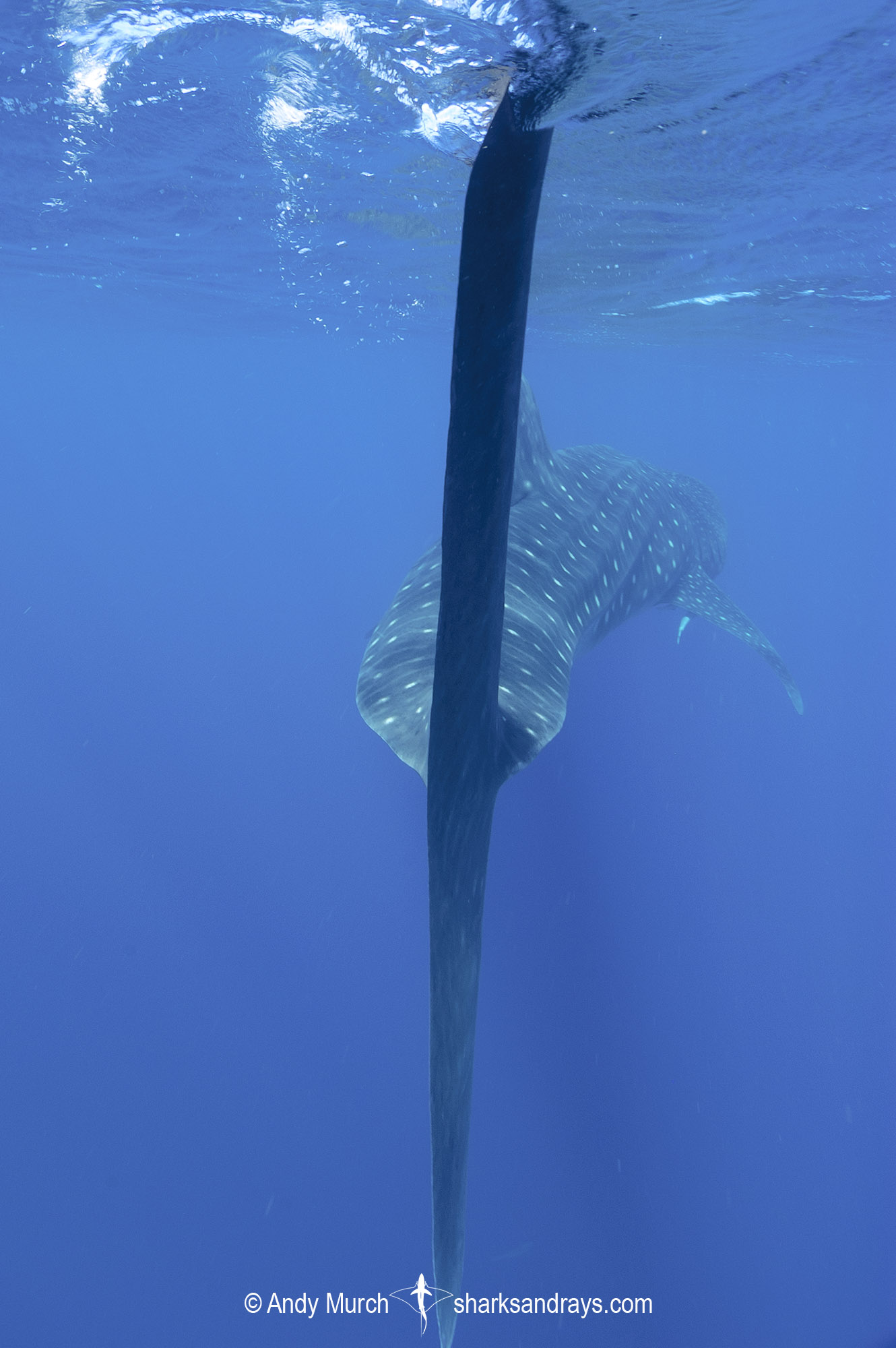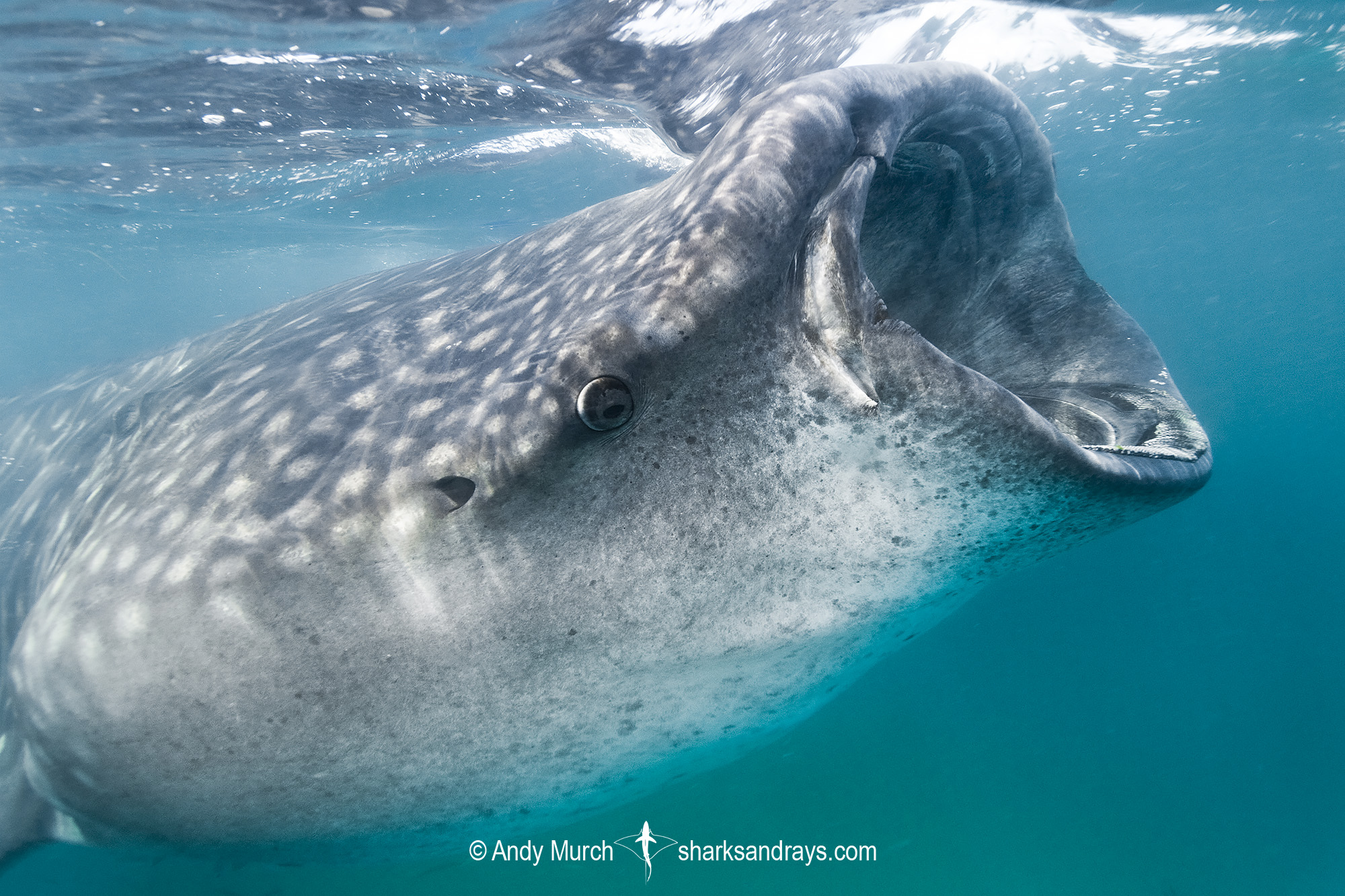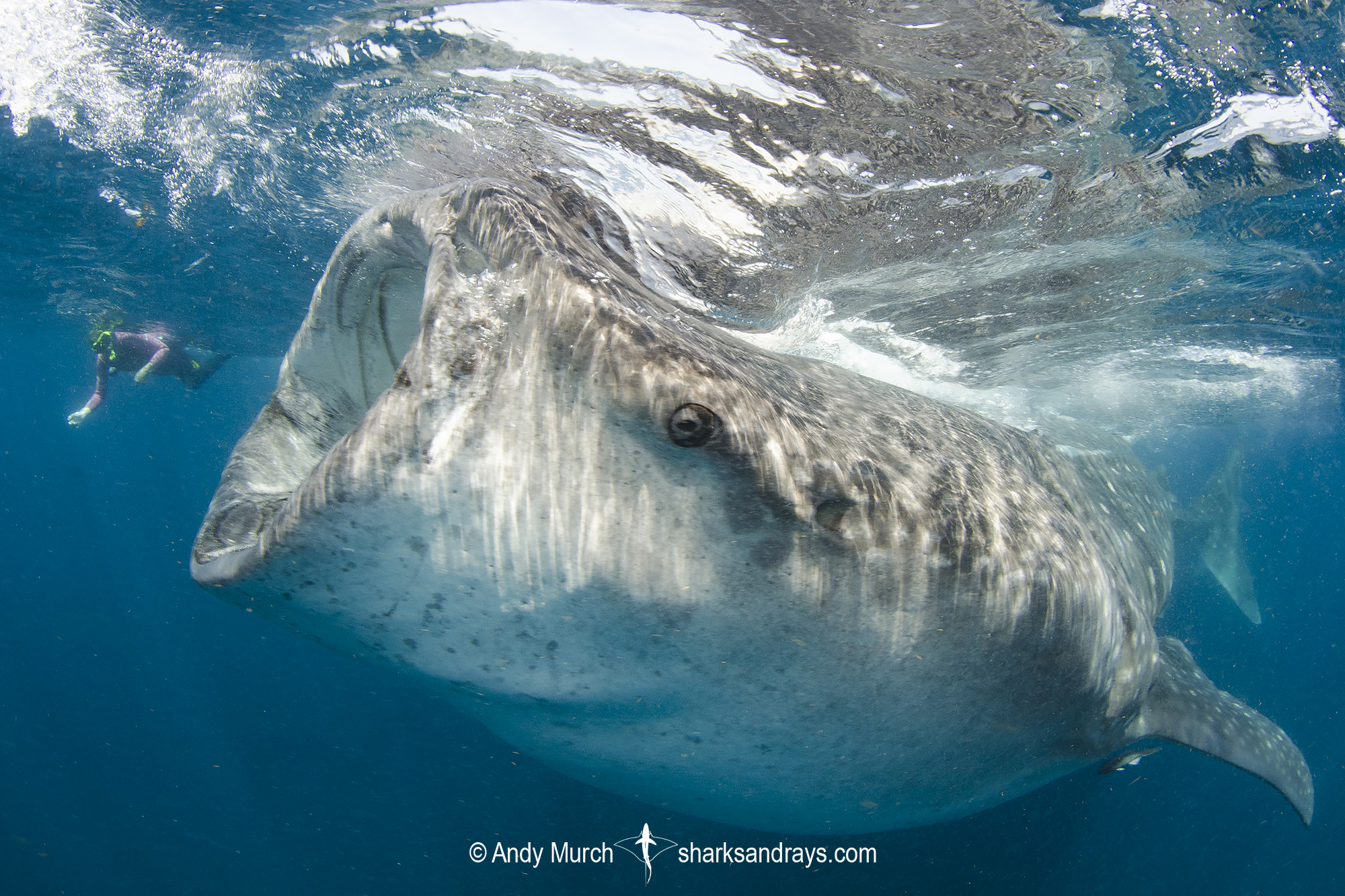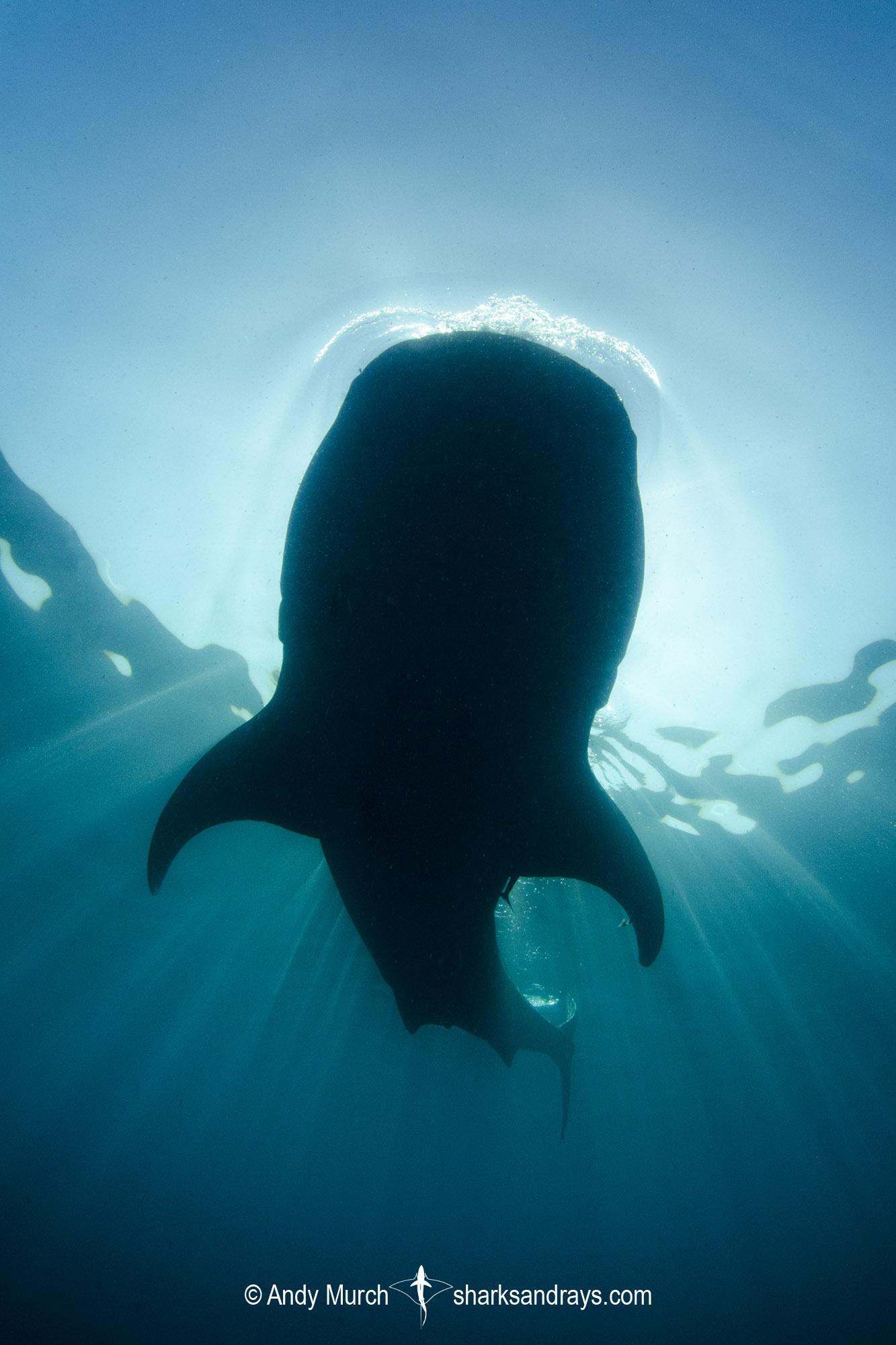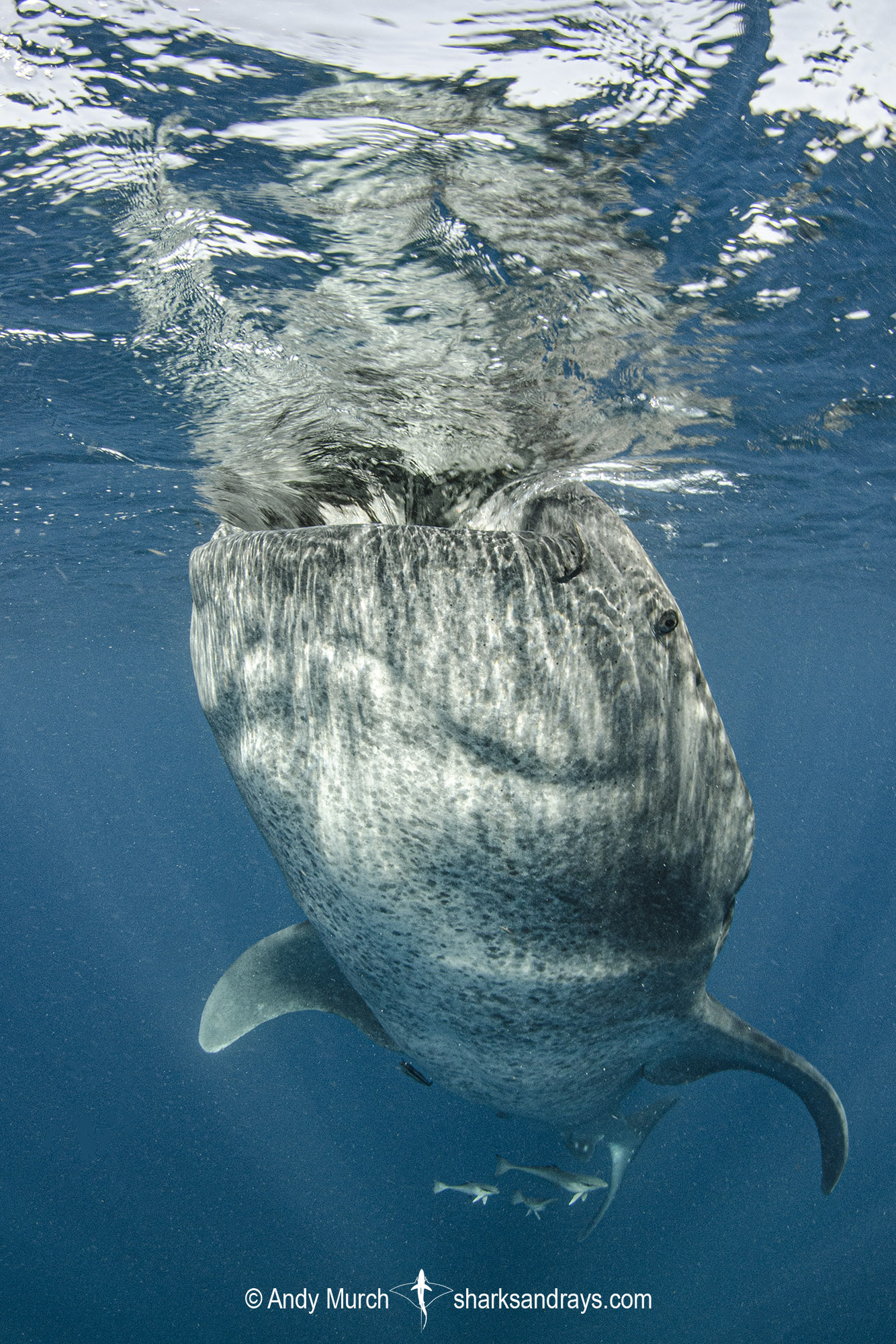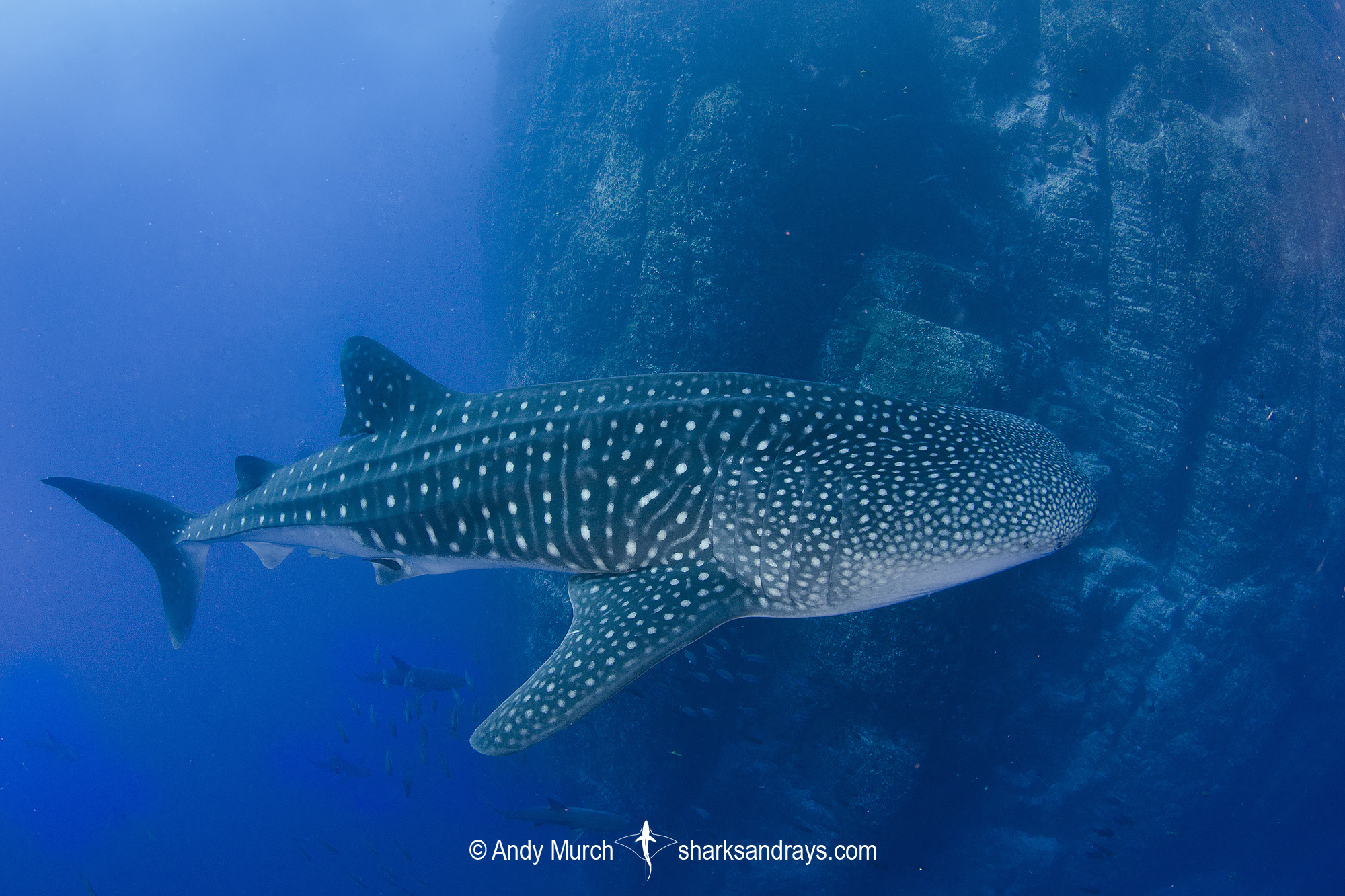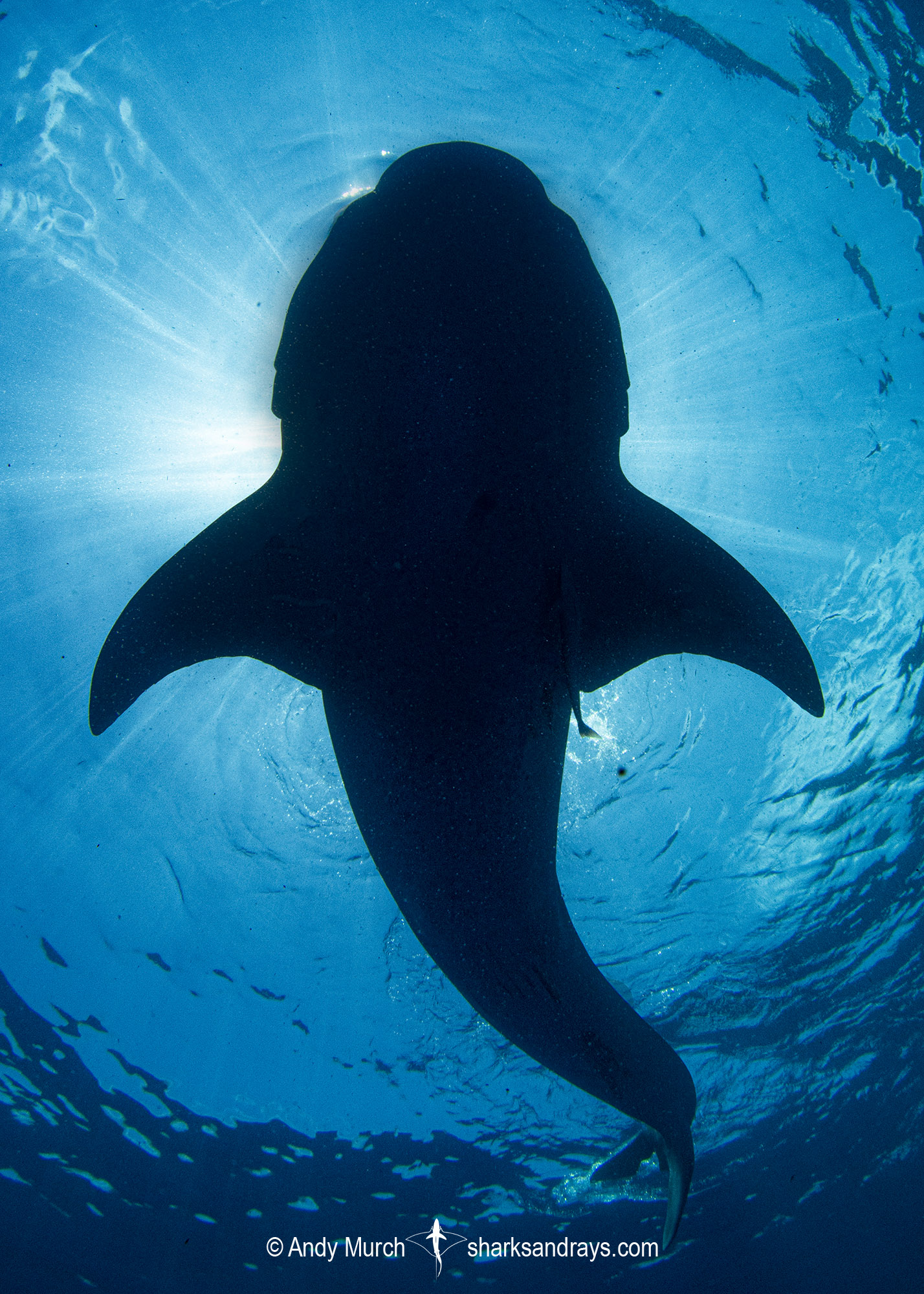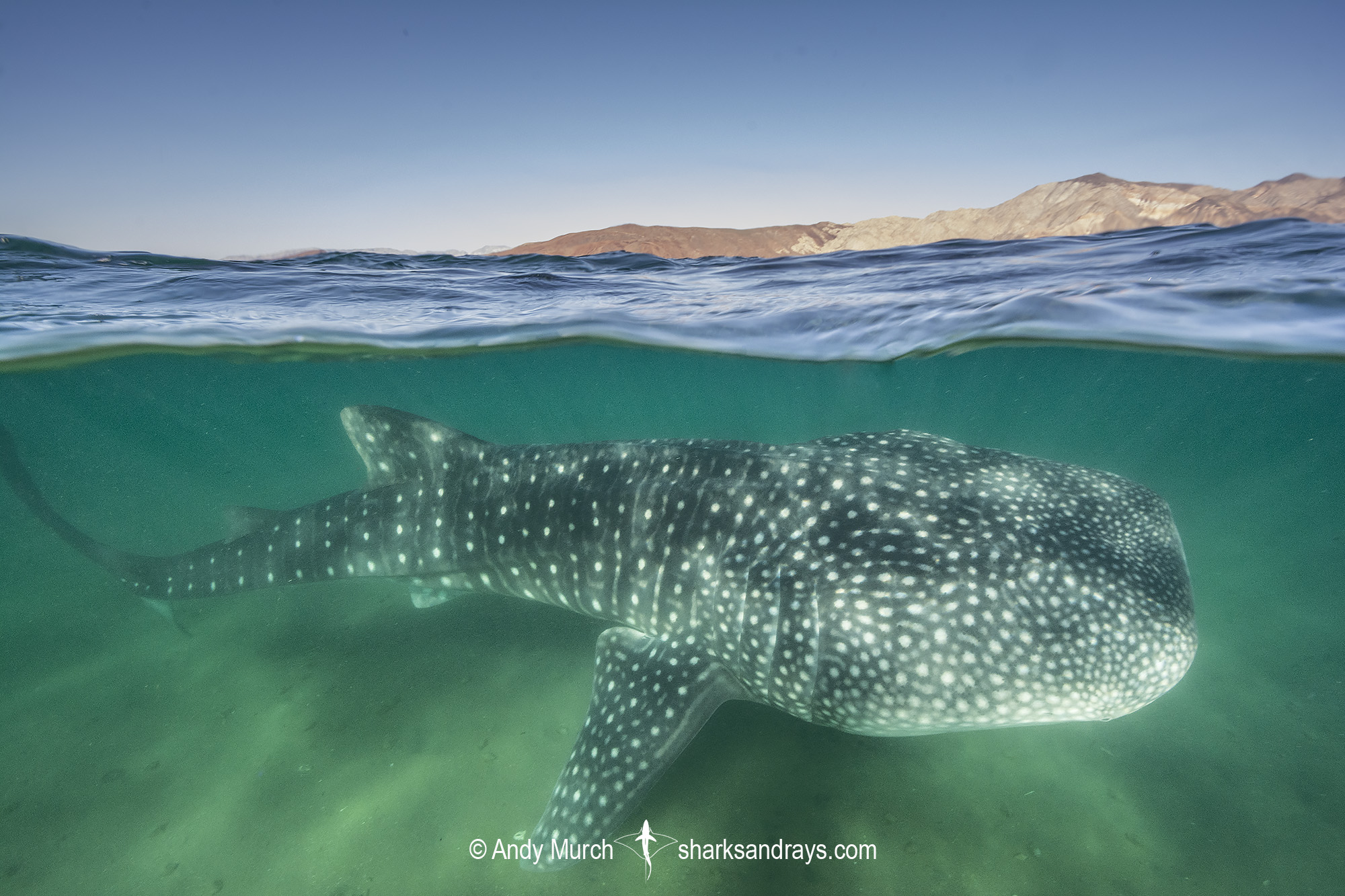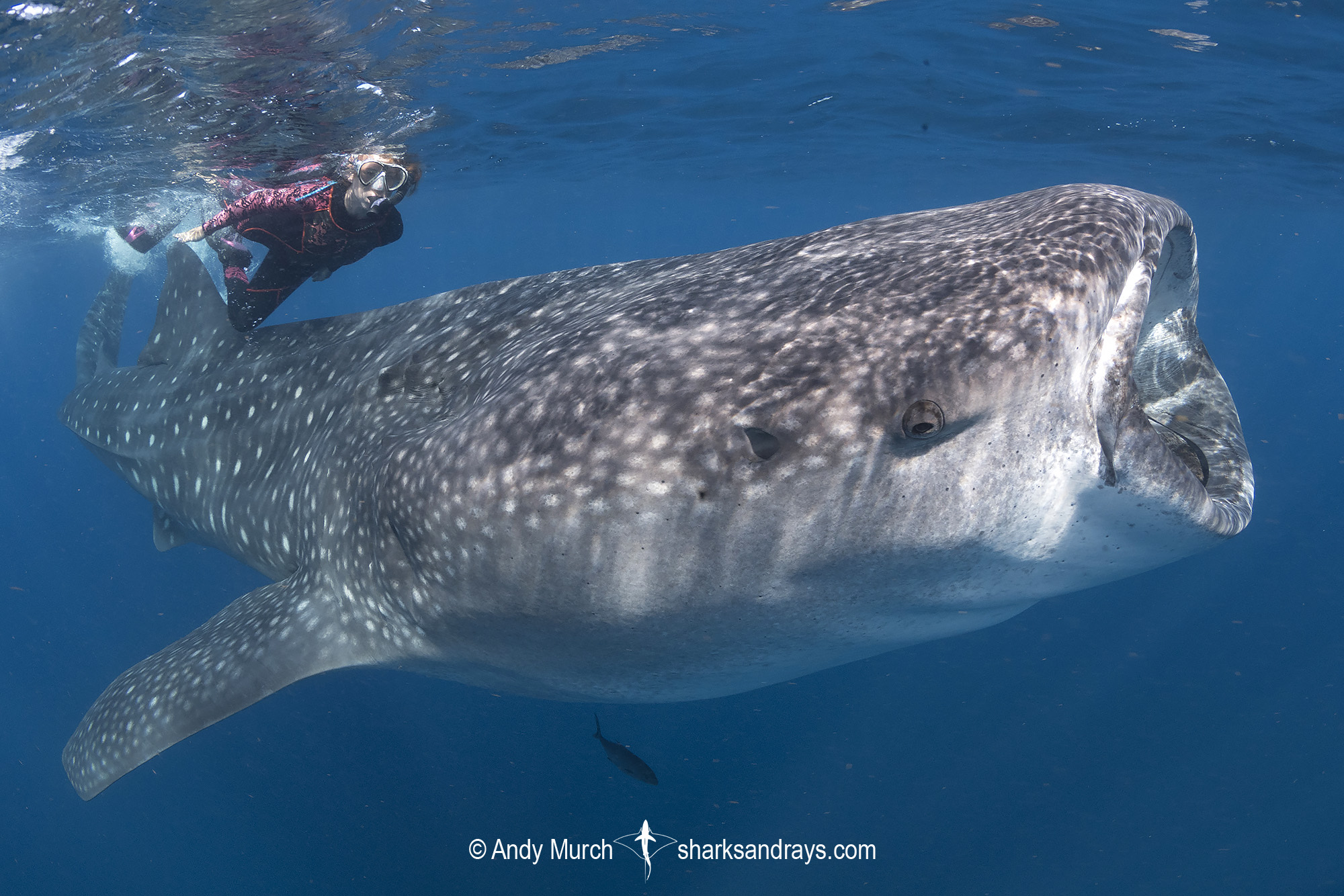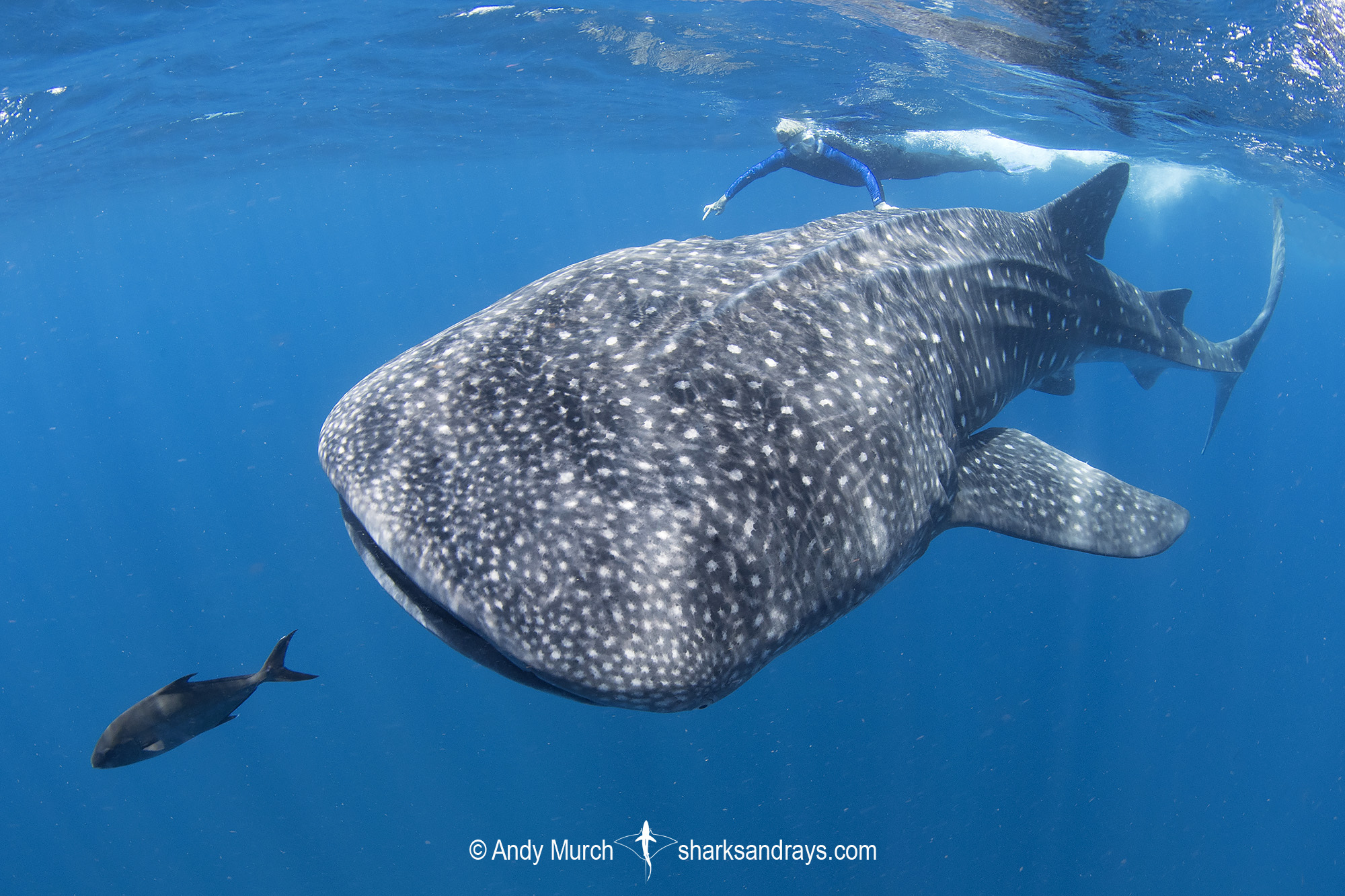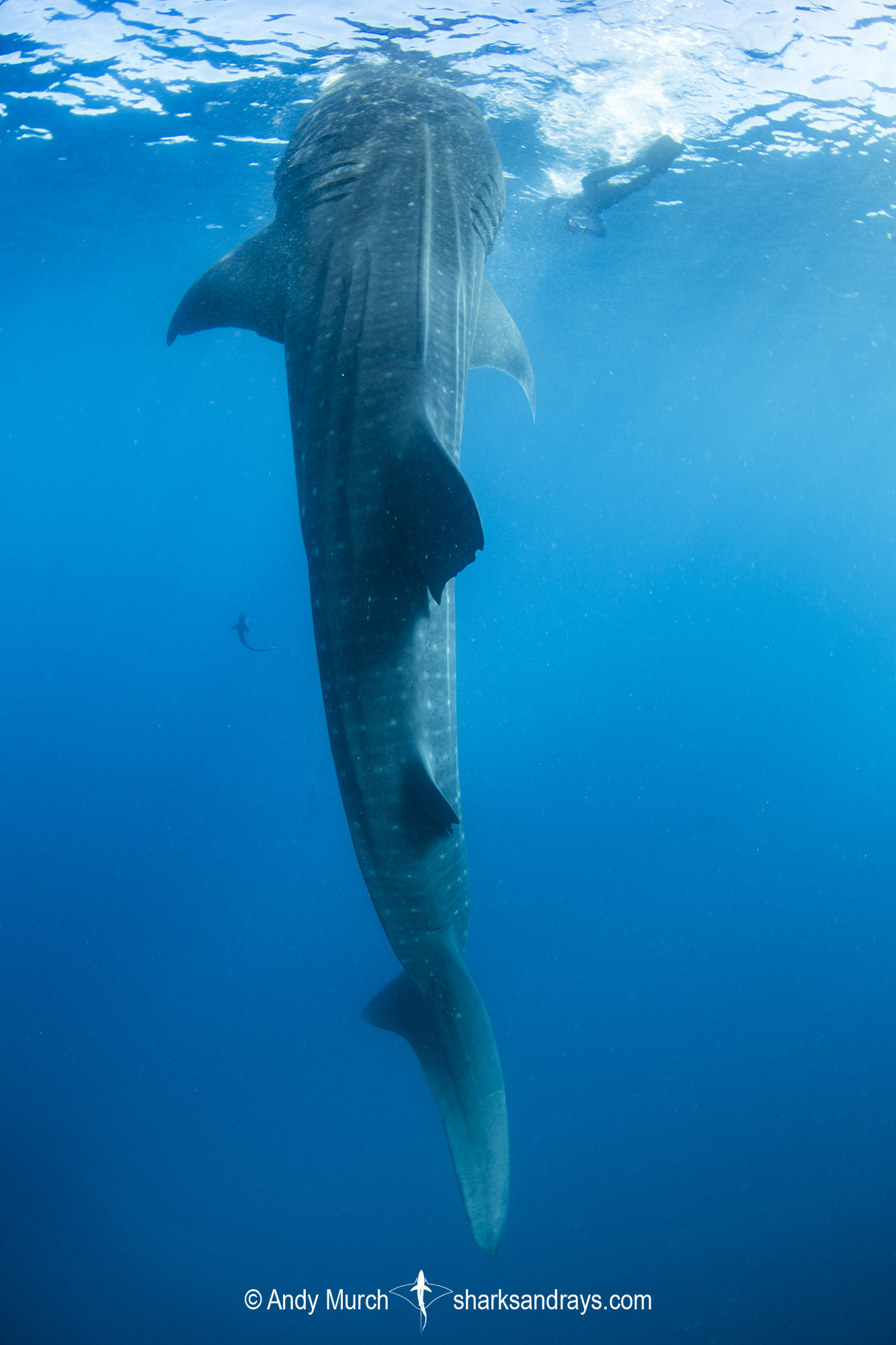Common names
Whale Shark.
Binomial
Rhincodon typus.
Synonyms
Micristodus punctatus, Rhicodon typus, Rhineodon typus, Rhiniodon typus, Rhinodon pentalineatus, Rhinodon typicus, Rhinodon typicus.
Identification
An extremely large, unmistakeable shark with a short snout and very wide terminal mouth. Eyes small. Small, short barbells extend from nasal openings. Gills long. First dorsal origin approximately one dorsal length behind pectoral fin free rear tip, and slightly anterior of pelvic fin origin. Second dorsal fin approximately half height of first dorsal fin, and equal in size to anal fin. Second dorsal origin over anal fin origin. Pectoral fins have concave posterior margins. Caudal fin Large. Upper caudal lobe approximately twice the length of lower caudal lobe. Three ridges run horizontally along flank from back of gills to base of caudal fin, with the lowest ridge forming a caudal keel.
Dorsum grey (sometimes with a bluish or brownish hue) with many small white or yellowish spots (arranged in vertical rows) and subtle thin vertical lines. Spots smaller on head.
Size
The whale shark is the largest shark/fish in the world with a potential maximum size 18m. However, very few large whale sharks have been credibly measured. The largest I am aware of was just over 13m in length. Regardless, this is a very large (and completely harmless) shark.
Size at birth 55-64cm.
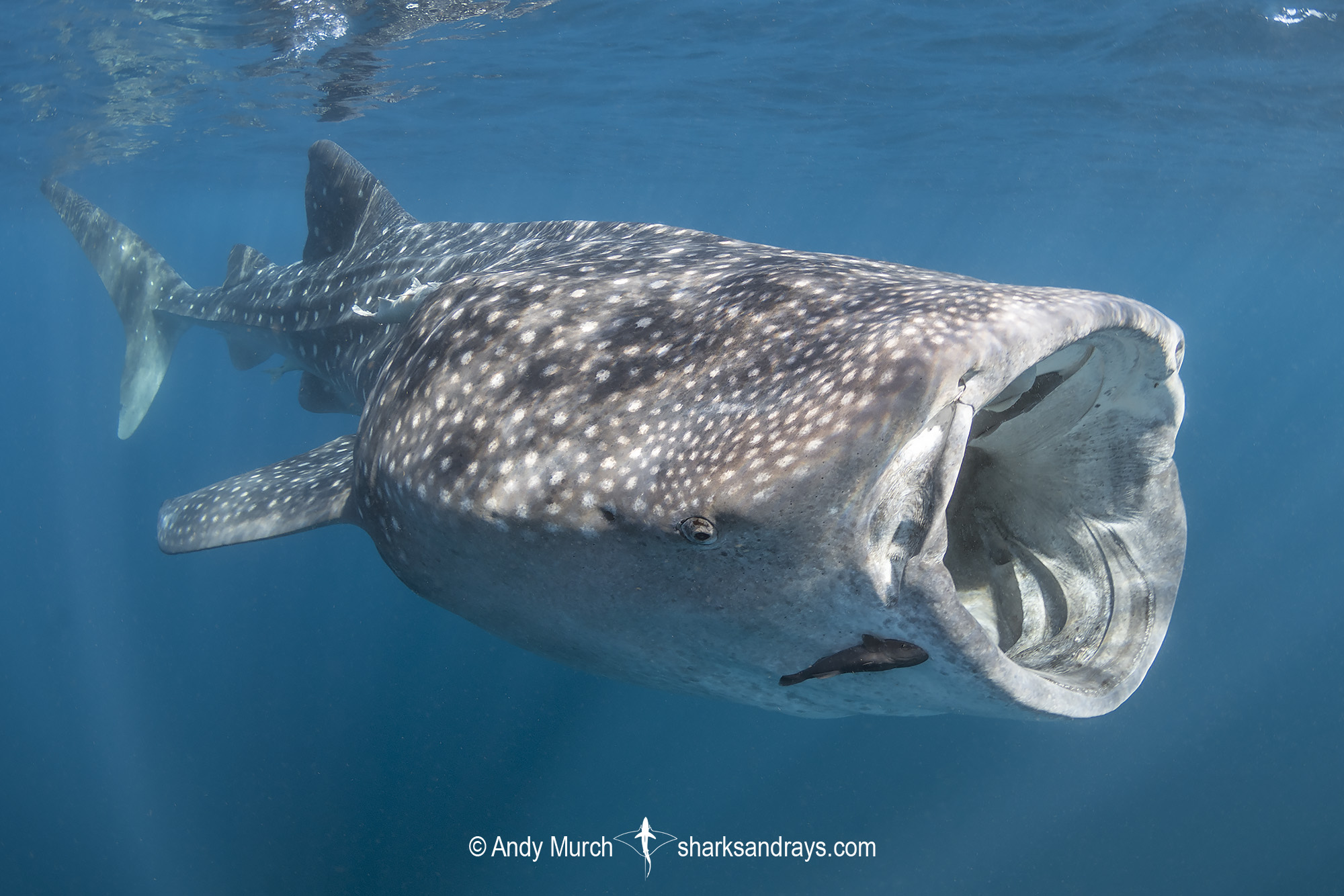
Conservation Status
ENDANGERED
Major threats to Whale Sharks include fisheries catches, bycatch in nets, and vessel strikes. Although some commercial fisheries for whale sharks closed during the 1990–2000s, Whale Shark fins, skin, and meat are highly sought after in some countries. Declines continue in many areas despite conservation measures.

Habitat
Inshore and oceanic in tropical and warm-temperate seas. The whale shark appears to prefer surface temperatures of 21-25ºC but in some areas they regularly dive to depths in excess of 1000m where water temperatures are vastly colder. Surface to at least 1928m
Distribution
Within its preferred temperature range, the whale shark has a cosmopolitan pelagic distribution across all of the world’s oceans.
Reproduction
Ovovipiparous (aka aplacental viviparous), but very few pregnant whale sharks have been examined.
It was long believed that whale sharks were oviparous, based on an egg case that was dredged from the sea floor in Mexico. The egg in question is now thought to have been aborted. Then in 1995, a 10.6m whale shark was harpooned in Taiwan that contained around 300 embryos of varying size. The largest of which were probably almost full term and lacked egg cases.
Diet
The whale shark is ram-feeding filter-feeder that consumes copious amounts of zooplankton such as crustaceans and fish eggs. They also feed on small schooling fishes and occasionally on larger fishes.
Where positively buoyant food occurs (such as mats of tuna eggs that float to the surface) aggregations of whale sharks can sometimes be seen ram feeding with their mouths partially above water. In particularly rich spots, they may also go vertical with their moth pointing out of the water and ‘gulp’ plankton until the thickest concentrations are gone and then continue ram feeding horizontally.
Behavior
Diurnal. Whale sharks undergo long seasonal migrations that often coincide with spawning events such as the tuna spawning event in mouth of the Gulf of Mexico that brings hundreds of whale sharks to the area each summer.
Reaction to divers
Whale sharks are fairly easy to approach but they usually outpace divers and snorkelers very quickly. They can bolt if molested, or if contact is made.
CAUTION: Some feeding events do not last very long so the sharks must consume as much plankton as possible in order to sustain them for (potentially) months at sea. Consequently, interfering with their ability to feed can be very detrimental to the sharks. Please NEVER ride whale sharks (by holding onto their dorsal fin) and discourage others from doing so if you witness it.
Diving logistics
There are quite a few places around the world where whale shark sightings are seasonably reliable. In some locations one might hope to see a handful of sharks, but in a few locations, snorkelers can swim with enormous aggregations, hundreds strong.
ISLA MUJERES, MEXICO:
From June to August, hundreds of whale sharks (and sometimes hundreds of Caribbean mantas) can be reliably found off the northern tip of the Yucatan, feeding on vast mats of invisible tuna eggs that drift out of the Gulf of Mexico. This is the largest known whale shark aggregation in the world. Most of the images on this page were taken during this annual event.
The water around Isla M. is exceptionally clear so the photographic opportunities are unparalleled. The one drawback of this encounter is the large number of boats that visit the aggregation, so it is important to go with a serious operator that can get you to the feeding grounds before the armada of tour boats arrive from Cancun each day, and stays until long after the regular tourists have returned to land. Big Fish Expeditions runs dedicated whale shark snorkeling trips from Isla Mujeres every July/August.
HOLBOX ISLAND, MEXICO
Isla Holbox lies to the west of Merida on the southern end of the Gulf of Mexico. It is another spot to see the same aggregation of whale sharks that show up near Isla Mujeres. However, the water in the Gulf is green and rich with plankton, so underwater encounters are challenging.
LA PAZ BAY, MEXICO
Whale sharks travel to La Paz to feed on plankton that ramps up against the shore in the huge shallow bay. I have seen whale sharks feeding in such shallow water that their pectorals were scraping the sand and their dorsal was out of the water. Unfortunately, visibility is terrible in the bay but the encounters are seasonably quite reliable.
BAHIA DE LOS ANGELES, MEXICO
By far the nicest spot to enjoy snorkeling with whale sharks on the Pacific side of Mexico. Whale sharks can be seen feeding right off the beach of this sleepy fishing village / tourist town. I visited by liveaboard but it is possible to stay in the town and go out on day tours to snorkel with the sharks. Photographers will be impressed by the opportunities to shoot over/unders with the mountains and cactus forests in the background.
SOCORRO ISLAND, MEXICO
During the summer months, whale sharks can be found at this offshore archipelago, 240km south of Baja. Many liveaboards run weeklong trips.
UPPER GULF OF MEXICO, USA
There is a large aggregation of whale sharks that forms in the northern gulf (off of Louisiana, Mississippi, and Alabama) each summer. I spent a week with researchers searching for them. We finally ran into a few but reports from fishermen indicate that there are sometimes hundreds. The ones we found were mostly feeding on mysids.
Because the encounters are unpredictable, there are no companies that offer tours but if you have time and access to a boat, this could be a great place to find your own private aggregation!
PLACENCIA, BELIZE
Traditionally, whale shark season in Belize was March to June but I have heard that the sharks have become quite scarce so it would be better to head further north to the tip of the Yucatan where they are still extremely plentiful.
UTILA ISLAND, HONDURAS
Whale sharks visit this area to feed on bait balls rather than plankton. Boats follow birds that swoop down when a bait ball is at the surface. The snorkelers then quickly jump in and try to keep up with the fast moving ball that is usually being fed on by tuna. The action is fast paced, with snorkelers having to climb back in the boat many times to catch up with the ball. It is exhausting but very interesting to watch a variety of predators attacking the tightly packed bait fish, and then watching a whale shark (or two) swim into the picture mouth agape to consume hundreds of fish with every lunge. The best season in Utila is February to April.
GALAPAGOS ISLANDS
If you want to see extremely large whale sharks, the northern Galapagos Islands (Wolf and Darwin) are probably the best spot. They can be seen at any time but the best season is June to October.
DONSOL AND OSLOB, PHILIPPINES
At these two spots in the Philippines, whale sharks are fed from small fishing boats. Recently, this practice has come under scrutiny because of the dangers of boat strikes and potential dependency on the fishermen. However, the tours continue.
Snorkelers (and sometimes divers) swim next to the boats while the fishermen funnel thousands of small fishes into the mouths of thee habituated sharks. Apparently, it gets extremely busy with snorkelers.
CHUMPON PINNACLE, THAILAND
Whale shark season is March to June at Chumpon Pinnacle; near Koa Tao on the Gulf side of Thailand. I saw my first whale shark here many years ago 🙂
Many rivers (including the mighty Mekong) dump silt into the gulf so the viz isn’t particularly good but the sharks don’t seem to mind. Sightings at the pinnacle can be a bit hit and miss.
There are numerous other islands around Thailand where whale sharks can be seen.
TRITON BAY, INDONESIA
This is another area where whale sharks are fed from fishing nets; this time from large fishing platforms. The same concerns for the whale sharks wellbeing apply here, but the area is quite remote so far fewer tourists go there.
NINGALOO REEF, AUSTRALIA
From April until early July, whale sharks can be seen ram feeding at the surface near Exmouth in Western Australia. The visibility is usually quite good but when I was there, the encounters were heavily regulated. That is not a bad thing for the sharks but we were not permitted to swim forward of the shark’s pectoral fins so dynamic photographs were virtually impossible.
MOZAMBIQUE
There are two spots where whale shark tours take place in Mozambique. In Tofo the best season is between September and February. In the Bazaruto Archipelago the season is between October and April.
KENYA
Operators in Diani Beach (and probably elsewhere) run whale sharks in season. Sightings appear to be fairly consistent. Whale shark season is mid February to mid March.
DJIBOUTI
Between November and February, whale sharks migrate to the Gulf of Tadjoura to feed on plankton upwellings. This aggregation is interesting because the juveniles that visit Djibouti are very small. In fact, these are the youngest whale sharks of any known site, with an average size of just four metres, with some individuals as small as two metres.
QATAR
Last but not least, there is a massive aggregation of whale sharks off the coast of Qatar between April and September. During the summer, this part of the Persian Gulf is oppressively warm. Plus, the spot where the whale sharks feed is only a few kms from the Iranian border, so there is very little tourism in general, but there is now a very luxurious liveaboard planning expeditions to swim with the whale sharks.
What’s new
View our full list of updates
Similar species
There are no other shark species that resemble the whale shark.



